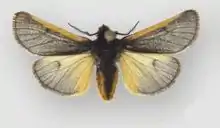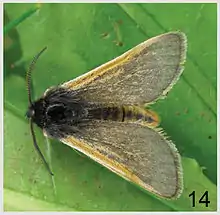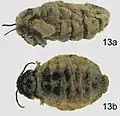Andesobia jelskii
Andesobia jelskii is a species of moth of the subfamily Arctiinae first described by Charles Oberthür in 1881. It is found in the Department of Junín in Peru.
| Andesobia jelskii | |
|---|---|
 | |
| Male | |
 | |
| Living male | |
| Scientific classification | |
| Kingdom: | |
| Phylum: | |
| Class: | |
| Order: | |
| Family: | |
| Subfamily: | |
| Genus: | |
| Species: | A. jelskii |
| Binomial name | |
| Andesobia jelskii | |
| Synonyms | |
| |
Adult
The forewings of the males have a length of 8–12 mm. The ground colour is brownish grey with a yellowish-ochre costal band varying to entirely dark brownish grey or pale ochre grey. There is an indistinct black discal spot, but other markings are obsolete. The hindwing ground colour is yellowish ochre with a broad, diffusely bordered grey-brown marginal band over the distal third of the wing, varying to entirely dark brownish grey. The forewings and hindwings of the females are micropterous (vestigial-winged) and highly reduced.
Egg
The egg is almost spherical, with the poles only very weakly flattened. It is ivory white changing to dark greyish white prior to hatching.
Larva
First-instar larva are initially translucent white, becoming opaque white. The second instar integument is black and the third instar has jet-black setae. The verrucae of the fourth instar are more pronounced than in previous instar. When mature, female larva are about twice as large as male larva.
Pupa
The cocoon is spherical to ovoid, reddish brown to dull brown, consisting of a single, thin and flimsy layer with incorporated larval setae.
Biology
First-instar larvae initially feed on the tissue of the dead or dying female, then leave the cocoon in search of plant material. Duration of the first instar is six days, second instar five to six days. The larvae are probably polyphagous and have been reared on Taraxacum and Poa species. The larvae emit an unpleasant odour of decay when disturbed. The cocoons are spun between leaves of the food plants near the ground. Adults emerge in the morning, with relatively fast expansion of the wings. Females remain in the loosely spun cocoon, and presumably emit mating pheromones from within the thin cocoon soon after emerging from the pupa, because males dig through the loose silk webbing to enter and mate inside the cocoon. The pair remains in copula for several hours, after which the male leaves the cocoon, and the female deposits about 50 eggs inside the cocoon.
Males are diurnal and fly rapidly during sunny periods. The flight period is early in the year (January), in the middle of the four-month wet season.
Gallery
 Female: lateral aspect (13a) and dorsal aspect (13b)
Female: lateral aspect (13a) and dorsal aspect (13b) Female pupa
Female pupa Mature larva
Mature larva Dark form of mature larva
Dark form of mature larva Male (lower arrow) and female (upper arrow) in copulo inside cocoon of female
Male (lower arrow) and female (upper arrow) in copulo inside cocoon of female
References
- Schmidt, C.; De Freina, J. (2011). "Generic placement of the Neotropical species of "Phragmatobia" (Erebidae, Arctiinae), with a remarkable matrivorous species from the Peruvian Andes". ZooKeys. 149 (149): 69–88. doi:10.3897/zookeys.149.2382. PMC 3234410. PMID 22207795.
